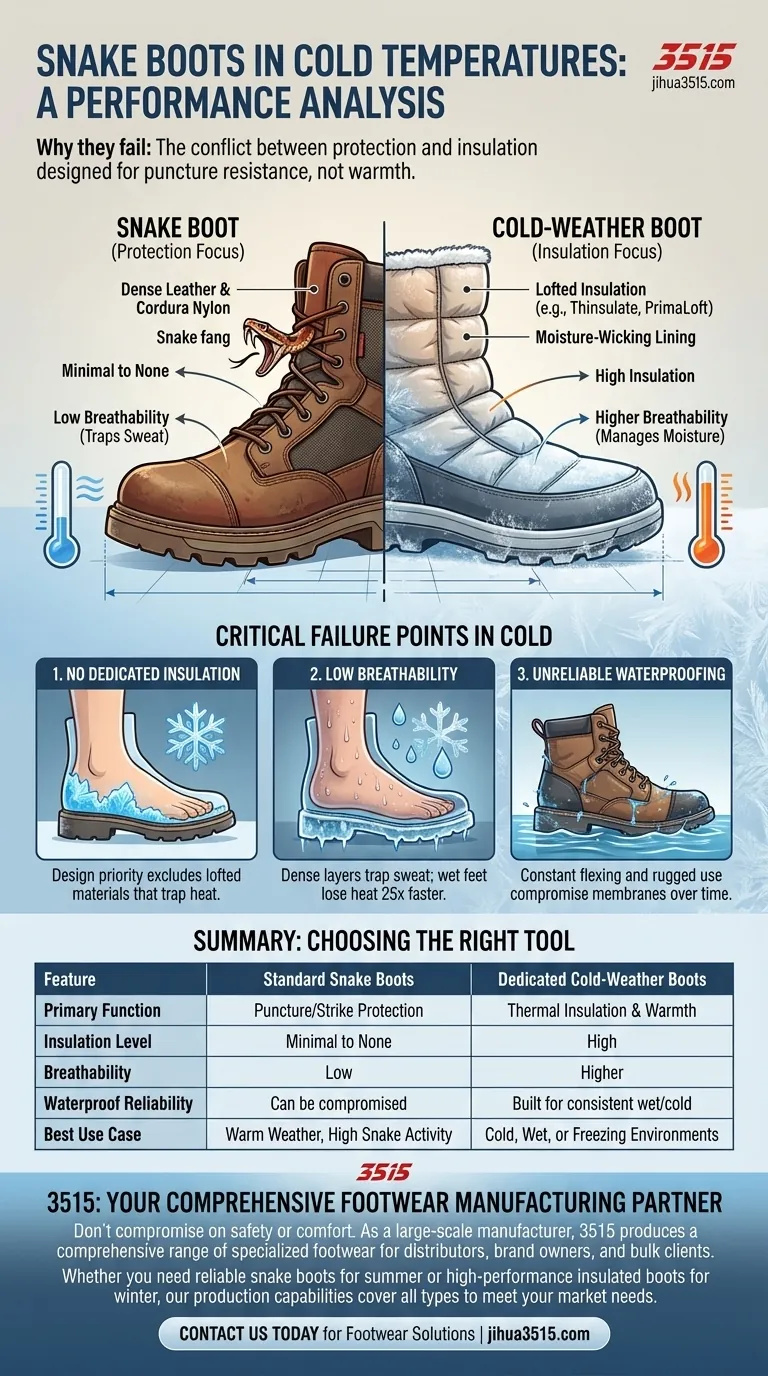In short, most snake boots perform poorly in cold temperatures. They are purpose-built for puncture resistance, not thermal insulation, meaning they typically lack the materials needed to keep your feet warm. For this reason, many hunters and outdoor enthusiasts switch to dedicated insulated boots once the weather turns cold and snake activity subsides.
The core issue is a conflict of design: The very materials that make a boot effective at stopping a snakebite are generally not the same materials that provide the insulation and reliable waterproofing required for cold-weather comfort.

The Core Conflict: Protection vs. Insulation
To understand why standard snake boots fail in the cold, you must look at their fundamental design. Their primary job is to create an impenetrable barrier, which dictates their material choices.
Designed for Puncture Resistance, Not Warmth
Snake boots rely on thick leather, dense Cordura nylon, or other synthetic weaves. These materials are chosen for their durability and tight construction to prevent a fang from passing through.
This design priority leaves little room for the lofted insulation (like Thinsulate or PrimaLoft) that traps air to keep your feet warm.
The Problem of Low Breathability
The dense, protective layers in many snake boots can also limit breathability. In cold weather, if your feet begin to sweat during activity, that moisture gets trapped.
Trapped moisture is the enemy of warmth. Wet socks will rapidly pull heat from your feet, making you feel colder than you would in a more breathable, insulated boot.
The Critical Role of Water Resistance
Staying dry is paramount to staying warm. While many snake boots claim to be waterproof, their performance in consistently wet and cold conditions is often a point of failure.
Why Dry Feet Equal Warm Feet
Water conducts heat away from your body approximately 25 times faster than air. Even a small amount of moisture from a leaky boot or trapped sweat can dramatically accelerate heat loss, leading to cold, uncomfortable feet.
The Reality of "Waterproof" Snake Boots
Even high-quality snake boots marketed as waterproof can develop leaks over time. The constant flexing from walking, combined with use in rugged terrain, can compromise seams and waterproof membranes.
This makes them an unreliable choice for consistently wet, swampy, or snowy environments where staying dry is non-negotiable for both comfort and safety.
Understanding the Trade-offs
Choosing a boot always involves balancing competing features. With snake boots, the trade-off is stark: you are prioritizing specialized protection over all-weather versatility.
The Insulation Gap
The single biggest trade-off is the lack of dedicated insulation. A true winter or cold-weather boot is built around an insulation package measured in grams. Most snake boots have zero grams of insulation.
Seasonal Suitability
Snake boots are a seasonal tool. They are designed for the warmer months when snakes are most active. Relying on them outside of this window means using a tool that is not suited for the environment, leading to discomfort and potential risk.
Bulk Without Benefit
While snake boots are often bulky and stiff due to their protective layers, this does not translate into warmth. You get the weight and inflexibility without the thermal benefit you would find in an insulated boot of similar size.
Making the Right Choice for Your Situation
Ultimately, your boot choice must match the specific conditions and risks of your environment.
- If your primary focus is mild autumn weather with some snake activity: A high-quality, reliably waterproof snake boot may be sufficient.
- If your primary focus is cold or freezing temperatures: A dedicated insulated and waterproof hunting or hiking boot is the correct and safer choice.
- If you need a single boot for all seasons: This is an unrealistic expectation; you must prioritize either snake protection for warm weather or insulation for cold weather.
Choose the specialized tool that best protects you from the most immediate environmental challenge you face.
Summary Table:
| Feature | Standard Snake Boots | Dedicated Cold-Weather Boots |
|---|---|---|
| Primary Function | Puncture/Strike Protection | Thermal Insulation & Warmth |
| Insulation Level | Minimal to None | High (e.g., Thinsulate, PrimaLoft) |
| Breathability | Low (Dense Protective Layers) | Higher (Designed for Moisture Management) |
| Waterproof Reliability | Can be compromised over time | Built for consistent wet/cold conditions |
| Best Use Case | Warm Weather, High Snake Activity | Cold, Wet, or Freezing Environments |
Don't compromise on safety or comfort. As a large-scale manufacturer, 3515 produces a comprehensive range of specialized footwear for distributors, brand owners, and bulk clients. Whether you need reliable snake boots for summer or high-performance insulated boots for winter, our production capabilities cover all types of shoes and boots to meet your specific needs. Contact us today to find the right footwear solution for your market!
Visual Guide

Related Products
- Safety Footwear Wholesale Manufacturer for Custom OEM/ODM Production
- Premium Grain Leather Safety Boots for Bulk Supply
- Wholesale Safety Footwear Manufacturer for Bulk & Custom OEM Orders
- Customizable Anti-Smash Safety Boots for Wholesale & Private Label Manufacturing
- Custom Wholesale Leather Safety Boots Direct Factory Manufacturing
People Also Ask
- What cultural and environmental considerations are tied to wearing shoes indoors? Balance Hygiene, Tradition, and Foot Health
- Is safety-toe as good as steel toe? Choose the Right Protection for Your Job
- What are OSHA approved shoes? Understanding the Correct Standards for Workplace Safety
- Is it normal to wear shoes in the house? A Guide to Hygiene, Comfort & Culture
- What do heavy duty boots do? Protect Your Feet in Demanding Work Environments



















